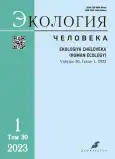Relationship of bioelemental status and changes in the functional state of the lungs in EMERCOM firefighters of Russia
- Authors: Vlasenko M.A.1, Sannikov M.V.1, Yakovleva M.V.1, Aleksanin S.S.1
-
Affiliations:
- Nikiforov’s All-Russian Center for Emergency and Radiation Medicine (the Nikiforov’s NRCERM)
- Issue: Vol 30, No 1 (2023)
- Pages: 55-64
- Section: ORIGINAL STUDY ARTICLES
- URL: https://journal-vniispk.ru/1728-0869/article/view/144183
- DOI: https://doi.org/10.17816/humeco108708
- ID: 144183
Cite item
Full Text
Abstract
BACKGROUND: Firefighters are characterized by constant interaction with smoke and various combustion products, which, entering the body can, affect the state of the respiratory system.
AIM: To study the relationship of the bioelemental status with alterations in the functional state of the lungs in firefighters of the Ministry of Emergency Situations of Russia.
METHODS: The work analyzed the data of 97 people from the territorial fire departments of the city of Saint Petersburg, directly involved in firefighting. The firefighters underwent a comprehensive medical examination, including an assessment of the bioelemental status in hair samples by inductively coupled plasma mass spectrometry.
RESULTS: As a result of the study, an increase in the content of toxic trace elements in firefighters was revealed in comparison with persons who did not participate in extinguishing the fire. Against the background of an increase in toxic trace elements, there was a decrease in vital ones. The relationship between the concentration of toxic trace elements and the state of the bronchopulmonary system in firefighters was revealed. The interrelation of the concentration of aluminum, silver and cadmium with a decrease in the diffusion capacity of the lungs, broncho obstructive changes and pulmonary fibrosis is shown. A significant increase in the content of silver was found in firefighters with broncho-obstructive changes compared to those with normal bronchial conduction.
CONCLUSION: The study illustrated the relationship between the levels of silver, aluminum, and cadmium and development of functional changes in the lungs..
Full Text
##article.viewOnOriginalSite##About the authors
Marija A. Vlasenko
Nikiforov’s All-Russian Center for Emergency and Radiation Medicine (the Nikiforov’s NRCERM)
Email: vlasenkomaria@gmail.com
ORCID iD: 0000-0003-2836-6891
SPIN-code: 6649-9224
MD, Cand. Sci. (Biol.), senior research associate
Russian Federation, Saint PetersburgMaksim V. Sannikov
Nikiforov’s All-Russian Center for Emergency and Radiation Medicine (the Nikiforov’s NRCERM)
Email: smakv@mail.ru
ORCID iD: 0000-0003-3969-9501
SPIN-code: 3663-4650
MD, Cand. Sci. (Med.), leader research associate
Russian Federation, Saint PetersburgMarija V. Yakovleva
Nikiforov’s All-Russian Center for Emergency and Radiation Medicine (the Nikiforov’s NRCERM)
Email: iakorobok@mail.ru
ORCID iD: 0000-0002-9709-8299
SPIN-code: 3229-4912
MD, Cand. Sci. (Biol.), leader research associate
Russian Federation, Saint PetersburgSergej S. Aleksanin
Nikiforov’s All-Russian Center for Emergency and Radiation Medicine (the Nikiforov’s NRCERM)
Author for correspondence.
Email: medicine@nrcerm.ru
ORCID iD: 0000-0001-6998-1669
SPIN-code: 1256-5967
MD, Dr. Sci. (Med.), professor, associate member of the Russian Academy of Sciences
Russian Federation, Saint PetersburgReferences
- Engelsman M, Toms LML, Banks A, et al. Biomonitoring in firefighters for volatile organic compounds, semivolatile organic compounds, persistent organic pollutants, and metals: a systematic review. Environ Res. 2020;188:109562. doi: 10.1016/j.envres.2020.109562
- Hu X, Chandler JD, Park S, et al. Low-dose cadmium disrupts mitochondrial citric acid cycle and lipid metabolism in mouse lung. Free Radic Biol Med. 2019;131:209–217. doi: 10.1016/j.freeradbiomed.2018.12.005
- Jing Y, Liu LZ, Jiang Y, et al. Cadmium increases HIF-1 and VEGF expression through ROS, ERK, and AKT signaling pathways and induces malignant transformation of human bronchial epithelial cells. Toxicol Sci. 2012;125(1):10–19. doi: 10.1093/toxsci/kfr256
- Sannikov MV, Aleksanin SS. Epidemiological analysis of results of in-depth medical examinations of professional rescuers of the EMERCOM of Russia. Medicо-Biological and Socio-Psychological Problems of Safety in Emergency Situations. 2009;(4):5–9. (In Russ).
- Kimura K, Nakano Y, Sugizaki T, et al. Protective effect of polaprezinc on cadmium-induced injury of lung epithelium. Metallomics. 2019;11(7):1310–1320. doi: 10.1039/c9mt00060g
- Vlasenko MA. Elementnyi status, pokazateli svobodnoradikal'nogo okisleniya i antioksidantnoi sistemy u sotrudnikov Federal'noi protivopozharnoi sluzhby MChS Rossii [dissertation]. Saint Petersburg, 2012. 24 p. Available from: https://www.dissercat.com/content/elementnyi-status-pokazateli-svobodnoradikalnogo-okisleniya-i-antioksidantnoi-sistemy-u-sotr (In Russ).
- Shantyr II, Yakovleva MV, Vlasenko MA, et al. Changes in the bioelemental state of firemen of the north-west region. Russian Journal of Occupational Health and Industrial Ecology. 2018;(4):33–37. (In Russ).
- Cheng X, Zhou YC, Zhou B, et al. Systematic analysis of concentrations of 52 elements in tumor and counterpart normal tissues of patients with nonsmall cell lung cancer. Cancer Med. 2019;8(18):7720–7727. doi: 10.1002/cam4.2629
- Go YM, Orr M, Jones DP. Actin cytoskeleton redox proteome oxidation by cadmium. Am J Physiol Lung Cell Mol Physiol. 2013;350(11):L831–L843. doi: 10.1152/ajplung.00203.2013
- Hu X, Fernandes J, Jones DP, Go YM. Cadmium stimulates myofibroblast differentiation and mouse lung fibrosis. Toxicology. 2017;383:50–56. doi: 10.1016/j.tox.2017.03.018
- Li FJ, Surolia R, Li H, et al. Low-dose cadmium exposure induces peribronchiolar fibrosis through site-specific phosphorylation of vimentin. Am J Physiol Lung Cell Mol Physiol. 2017;313(1):L80–L91. doi: 10.1152/ajplung.00087.2017
- Tao C, Pei Y, Zhang L, Zhang Y. Microbial communities respond to microenvironments in lungs of mice under simulated exposure to cadmium aerosols. Sci Total Environ. 2020;710:136300. doi: 10.1016/j.scitotenv.2019.136300
- Assad N, Sood A, Campen MJ, Zychowski KE. Metals-induced pulmonary fibrosis. Curr Environ Health Rep. 2018;5(4):486–498. doi: 10.1007/s40572-018-0219-7
- Braakhuis HM, Cassee FR, Fokkens PH, et al. Identification of the appropriate dose metric for pulmonary inflammation of silver nanoparticles in an inhalation toxicity study. Nanotoxicology. 2016;10(1):63–73. doi: 10.3109/17435390.2015.1012184
- Ma W, He S, Ma H, et al. Silver nanoparticle exposure causes pulmonary structural damage and mitochondrial dynamic imbalance in the rat: protective effects of sodium selenite. Int J Nanomedicine. 2020;15:633–645. doi: 10.2147/IJN.S232986
- Cao DJ, Aldy K, Hsu S, et al. Review of health consequences of electronic cigarettes and the outbreak of electronic cigarette or vaping product use-associated lung injury. J Med Toxicol. 2020;16(3):295–310. doi: 10.1007/s13181-020-00772-w
- Guo C, Buckley A, Marczylo T, et al. The small airway epithelium as a target for the adverse pulmonary effects of silver nanoparticle inhalation. Nanotoxicology. 2018;12(6):539–553. doi: 10.1080/17435390.2018.1465140
- Feng W, Huang X, Zhang C, et al. The dose–response association of urinary metals with altered pulmonary function and risks of restrictive and obstructive lung diseases: a population-based study in China. BMJ Open. 2015;5(5):e007643. doi: 10.1136/bmjopen-2015-007643
Supplementary files












